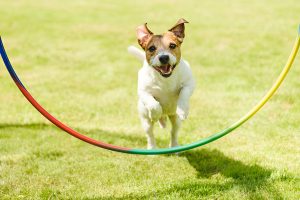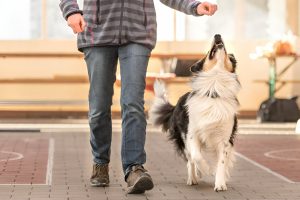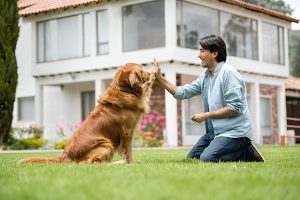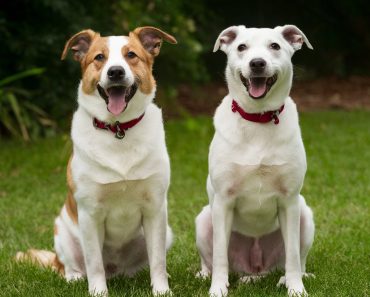dog Training your offers a multitude of benefits that go beyond just teaching basic commands; it significantly enhances the bond between you and your pet. Here are some key ways in which Dog Training strengthens your relationship:
Enhanced Communication and Trust Dog Training

Dog Training
Enhanced communication and trust are fundamental benefits of dog training, significantly improving the relationship between you and your pet.
Enhanced Communication
Training your dog establishes a clear line of communication. When you consistently use commands and provide feedback, your dog learns to understand what is expected. This mutual understanding is crucial for effective communication. For instance, commands like “sit,” “stay,” and “come” provide structure and predictability, helping your dog navigate the human world more easily.
Building Trust
Training sessions involve a lot of positive reinforcement, which helps build trust between you and your dog. When your dog receives praise or treats for following commands, it learns to associate your presence and instructions with positive outcomes. This builds a strong foundation of trust, as your dog begins to see you as a reliable leader and source of guidance.
Consistent and Positive Interactions
Regular training sessions create consistent interactions between you and your dog. This consistency is reassuring for your pet, as it knows what to expect and what is expected of it. Consistent training with positive reinforcement also helps prevent misunderstandings and reduces frustration for both you and your dog.
Improved Responsiveness
A well-trained dog is more responsive to commands, which can enhance safety and ease in various situations. For example, if your dog knows and responds to the “come” command, it is less likely to run into dangerous situations, like traffic. This responsiveness is a direct result of the trust and communication developed through training.
Mutual Respect
Training fosters a relationship based on mutual respect. As your dog learns to obey commands and trust your guidance, it also learns to respect your role as its leader. This mutual respect strengthens the bond between you and creates a more harmonious living situation.
Overall, training is not just about teaching your dog to follow commands; it’s about building a strong, trusting relationship through clear communication and consistent, positive interactions. This bond will enhance your overall experience as a pet owner and contribute to your dog’s well-being and happiness.
Improved Safety Dogs
Preventing Dangerous Behaviors
Training helps eliminate dangerous behaviors such as running into traffic, jumping on strangers, or aggressive reactions to other dogs. Commands like “stay” and “come” are essential for controlling your dog’s movements in potentially hazardous situations. For example, if your dog is about to dart across a busy street, a well-practiced “stay” command can prevent an accident .
Enhancing Recall Abilities
One of the most critical commands for safety is “recall” or “come.” A strong recall ability ensures that your dog will return to you immediately when called, which can be lifesaving in situations where your dog might be at risk, such as encountering wildlife or approaching an unsafe area .
Reducing Risk of Injury
Training can teach your dog to avoid dangerous objects and situations. For instance, commands like “leave it” or “drop it” can prevent your dog from picking up harmful items like sharp objects, poisonous substances, or choking hazards. This reduces the risk of injury or poisoning, contributing to your dog’s overall safety .
Socialization Skills

Dog Training
Proper training includes socialization, which helps your dog behave appropriately around other dogs and people. Socialized dogs are less likely to engage in fights or display aggressive behavior, which can prevent injuries to themselves and others. This makes walks and visits to parks much safer and more enjoyable .
Emergency Situations
Training prepares your dog to respond appropriately in emergencies. For example, a well-trained dog can stay calm and follow commands during natural disasters, accidents, or sudden changes in the environment. This calm behavior can prevent panic-induced accidents or injuries and make it easier to evacuate or move your dog to safety if needed.
Obedience in Public Spaces
Training ensures that your dog can safely accompany you to various public places without causing disruptions or getting into trouble. A dog that reliably follows commands in public spaces is less likely to get lost or involved in incidents, thereby enhancing their safety and the safety of others around them.
In summary, training your dog not only makes them a better-behaved companion but also significantly enhances their safety. By teaching your dog to respond to commands and behave appropriately in various situations, you can protect them from potential dangers and ensure a safer environment for everyone.
Mental Stimulation and Physical Exercise
Mental Stimulation
- Cognitive Challenges: Training exercises challenge your dog’s brain, requiring them to think and solve problems. This cognitive engagement helps keep their minds sharp and can prevent boredom, which often leads to destructive behaviors. For example, teaching your dog new tricks or commands forces them to focus and learn, providing significant mental exercise.
- Learning New Skills: As dogs learn new commands and behaviors, they are mentally stimulated. Trick training, such as learning to “roll over” or “play dead,” provides fun and engaging ways for dogs to use their cognitive abilities. This kind of mental workout can be as tiring for dogs as physical exercise.
- Interactive Toys and Puzzles: Incorporating training with interactive toys or puzzle feeders can provide additional mental stimulation. These toys require dogs to figure out how to access treats, keeping them engaged and mentally active.
Physical Exercise
- Increased Activity Levels: Training sessions often involve physical activities such as running, fetching, or agility exercises. These activities help your dog burn off excess energy, maintain a healthy weight, and improve overall fitness. Commands like “fetch” or “jump” during agility training keep your dog moving and physically engaged .
- Structured Playtime: Training can be incorporated into play, making exercise more structured and purposeful. Games like tug-of-war, hide-and-seek, or fetch can be used to reinforce commands while providing a fun way for your dog to get exercise .
- Enhanced Coordination and Balance: Training activities, especially those involving agility, help improve your dog’s coordination and balance. Navigating obstacle courses, weaving through poles, or jumping through hoops not only provides physical exercise but also improves your dog’s motor skills.
Combined Benefits
- Behavior Improvement: Regular mental and physical exercise can significantly improve your dog’s behavior. A tired dog is less likely to engage in undesirable behaviors like excessive barking or chewing. Mental and physical stimulation helps to keep them calm and content.
- Stress Reduction: Both mental and physical exercises are effective in reducing stress and anxiety in dogs. Engaging in training provides an outlet for pent-up energy and can help dogs feel more secure and relaxed.
Socialization and Manners
Socialization
- Exposure to Different Environments: Socialization involves exposing your dog to various environments, people, and other animals. This exposure helps reduce fear and anxiety, making your dog more comfortable in different settings. Well-socialized dogs are more adaptable and less likely to exhibit stress-related behaviors.
- Interaction with Other Dogs and People: Training classes and controlled socialization sessions allow dogs to interact positively with other dogs and people. These interactions are crucial for teaching your dog how to behave appropriately in social situations, reducing the likelihood of aggressive or fearful responses.
- Building Confidence: Regular socialization helps build your dog’s confidence. Dogs that are exposed to a variety of experiences are less likely to be fearful or anxious in new situations. Confident dogs are generally happier and more relaxed, which improves their overall quality of life.
Manners
- Basic Obedience: Teaching your dog basic manners such as “sit,” “stay,” “down,” and “leave it” is fundamental for good behavior. These commands help manage your dog’s actions, ensuring they are well-behaved in different situations, from home settings to public spaces.
- Polite Greeting Behaviors: Training your dog not to jump on people, to wait calmly for petting, and to respond to commands when greeting new people ensures positive interactions. Good manners in greeting can prevent accidental injuries or discomfort for guests and make social visits more pleasant.
- Respectful Behavior Around Food: Training your dog to behave appropriately around food, such as not begging or stealing from tables, instills good manners that make mealtime more enjoyable and stress-free for everyone. This training also prevents potential food-related conflicts with other pets or people.
Combined Benefits

Dog Training
- Safer Interactions: Well-socialized dogs with good manners are safer to be around. They are less likely to exhibit aggression or fear-based behaviors, which can lead to bites or other incidents. Proper training ensures that your dog can interact safely with people and other animals.
- Enhanced Enjoyment of Public Outings: A dog with good social skills and manners can accompany you to various public places, such as parks, cafes, and social gatherings. This not only enriches your dog’s life with new experiences but also allows you to enjoy their company more fully in diverse settings.
- Strengthened Bond: The process of teaching your dog social skills and manners through consistent training and positive reinforcement strengthens the bond between you and your dog. This mutual understanding and respect lead to a more harmonious relationship.
Strengthened Bond through Shared Activities
Collaborative Learning
- Training Sessions: Regular training sessions where you teach your dog new commands or tricks are excellent for bonding. These sessions require both you and your dog to focus on each other, promoting mutual understanding and communication. The positive reinforcement used in training (praise, treats, or play) helps build trust and a positive association with learning together.
- Trick Training: Beyond basic obedience, teaching your dog fun tricks like “roll over,” “high five,” or “play dead” can be a joyful and rewarding experience. Trick training keeps your dog mentally stimulated and provides opportunities for playful interaction, which strengthens your bond through shared achievement and enjoyment.
Interactive Play
- Fetch and Tug-of-War: Playing games like fetch or tug-of-war are not only physically beneficial but also serve as a way to reinforce commands like “drop it” and “fetch.” These games are collaborative and help your dog see you as a fun and engaging partner.
- Hide and Seek: Playing hide and seek with your dog can be an exciting way to engage them mentally and physically. It encourages your dog to use their senses to find you, promoting problem-solving skills and adding an element of fun to your interaction.
Outdoor Adventures
- Walks and Hikes: Regular walks or hikes offer excellent opportunities for bonding. These outings allow your dog to explore new environments while maintaining a connection with you. Training your dog to walk nicely on a leash and respond to commands during walks ensures these experiences are pleasant and stress-free for both of you.
- Dog Sports: Participating in dog sports such as agility, flyball, or obedience competitions can be highly rewarding. These activities require teamwork and enhance your dog’s physical fitness and mental sharpness. Competing or training for these sports builds a sense of partnership and deepens your bond through shared goals and successes.
Routine Activities
- Daily Routines: Incorporating training into daily routines, such as practicing commands before meals or during playtime, reinforces your dog’s skills and integrates learning into everyday life. These consistent interactions help solidify your dog’s understanding and responsiveness while strengthening your bond through routine engagement.
- Grooming and Care: Regular grooming sessions, including brushing, nail trimming, and dental care, provide additional bonding time. These activities require your dog to trust you and remain calm, reinforcing your role as a caring and reliable caregiver.
Stress Reduction and Improved Behavior
Stress Reduction
- Predictability and Routine: Training introduces structure and predictability into a dog’s life, which can significantly reduce anxiety. Knowing what to expect and understanding commands makes dogs feel more secure and less stressed.
- Mental and Physical Exercise: Engaging in regular training sessions provides mental and physical stimulation, which helps alleviate stress. Activities that challenge a dog’s mind and body can tire them out in a healthy way, reducing the likelihood of anxiety-driven behaviors.
- Positive Reinforcement: Training with positive reinforcement creates a positive association with learning and following commands. This method reduces fear and stress associated with punishment-based training techniques. Dogs that are rewarded for good behavior are happier and more relaxed.
- Building Confidence: Training helps build a dog’s confidence by providing clear guidelines and rewarding successful actions. A confident dog is less likely to experience stress in new or challenging situations because they have learned to trust their owner and their training.
Improved Behavior
- Obedience and Control: Training improves a dog’s obedience and overall behavior. Commands such as “sit,” “stay,” and “leave it” help manage and control a dog’s actions, making them less likely to engage in unwanted behaviors like jumping on guests, barking excessively, or chewing on furniture.
- Behavior Modification: Training can address specific behavioral issues such as aggression, separation anxiety, and fearfulness. Techniques such as counter-conditioning and desensitization can change how a dog responds to triggers, leading to better behavior over time.
- Social Skills: Proper training includes socialization, which helps dogs learn how to behave appropriately around other dogs and people. Well-socialized dogs are less likely to exhibit aggressive or fearful behaviors, making them more pleasant companions in social settings.
- Consistent Reinforcement: Consistent training reinforces desired behaviors and helps dogs understand what is expected of them. This consistency leads to better-behaved dogs who are more responsive to commands and less likely to act out due to confusion or lack of guidance.
By investing time and effort into training your dog, you not only improve their behavior and safety but also deepen the emotional connection you share. This strong bond will lead to a more fulfilling and harmonious relationship with your furry friend.






